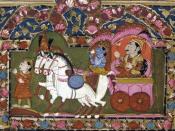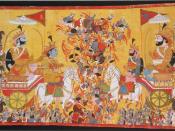The prima facie difference between the first-person's perspective and the third-person's perspective is the nature of the claims made. The first-person's perspective makes introspective claims about human freedom. It asks the question; am I free? The third-person perspective makes claims from the outside looking in. It asks the question; is she free? At the same time, they are both analysing the same thing; human freedom. They argue from premises about personal identity to conclusions about freedom. Their knowledge is drawn from the content of human experience, and their reasoning is based on logic. Indeed, the first-person metaphysical model of the Hindus resembles the third-person model of Kant. Similarly, Hume's model, and his argument, closely resembles Buddhism. This dichotomy is interesting, as Buddha's model was a response to Hinduism, and, conversely, Kant was responding to Hume. This essay is an examination of the similarities and differences between Hinduism and Kant, and Buddhism and Hume.
The purpose of this examination is to see whether the difference in perspective leads to other differences in the analysis of the similar model. Hindu Analysis of Freedom The Hindu account of personal identity revolves around an eternal subject, or "self". The Upanisads use the metaphor of a passenger in a chariot to describe the self . The intellect is the chariot driver, the mind is the reins, the body is the chariot, the horses are the senses and the objects of sense are the lands they travel over. Essentially, this eternal self, or "âtman", is the passive subject of perception. It is the thing that sees when I see, the thing that feels when I feel and the thing that thinks when I think. ÃÂtman cannot be sensed, or "sought by outward knowledge" . It can never be one of the objects that it perceives, as...



I like it
i think u got ur information across pretty clearly, keep it up
1 out of 1 people found this comment useful.